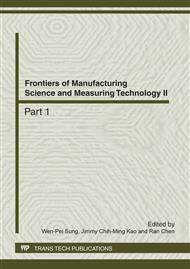p.3
p.7
p.11
p.15
p.19
p.23
p.27
p.31
Research of Parts’ Clustering Method for the Multi-Design Objective
Abstract:
The goal of product design is to meet the anticipated design goal. The market demands of congeneric products have difference in type of construction and quantity, so the design objective of products shouldn’t be same. The process of product’s modularization should accommodate the multi-design objective. It should be taken into account in the process of parts’ clustering not only the parts’ feature but also specific service condition of the parts. The rules and the its factor weight are determined impersonally by the method of AHP(Analytic Hierarchy Process) for the different goal. The different calculated methods are adopted base on the different character between the parts’ interaction values, and the objectivity and accuracy have been improved. The effectiveness of the clustering method has been proved by an example and the different clustering results have been found for different design goal.
Info:
Periodical:
Pages:
3-6
Citation:
Online since:
April 2012
Authors:
Keywords:
Price:
Сopyright:
© 2012 Trans Tech Publications Ltd. All Rights Reserved
Share:
Citation:


